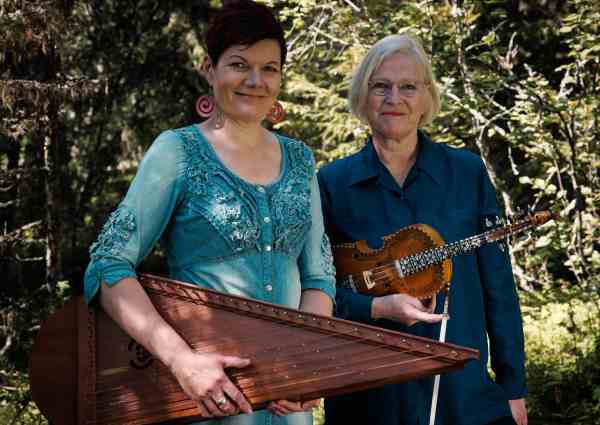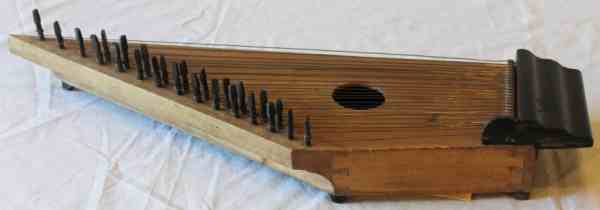

Arja Kastinen
Pauliina Syrjälä & Ragnhild Knudsen Article by Andrew Cronshaw
Zithers. The world is full of ‘em. It’s a very wide term, generically meaning an instrument with one or more strings stretched over, and parallel to, a sound-box of some sort, without a neck.
In the Baltic region there’s a range of traditional zithers: in Finland kantele, in Estonia kannel, in Latvia kokle, in Lithuania kankles (and eastward, across the peoples of the Russian Federation, there’s gusli and more), each with considerable variation of design and construction. Finland in particular has, since the late 20th century, seen a resurgence of interest and the development of skills and in the construction of the instruments. Here are a couple of recent Finnish kantele album releases - Kantervo by Arja Kastinen and Talende strenger / Kertovat Kielet by Pauliina Syrjälä and Ragnhild Knudsen. I'll also talk a bit about the diverse forms of the instrument, and mention some significant players of the present and past. The simplest and oldest form of Finnish kantele has five strings, but other forms range up to about thirty-nine. The latter is the big, deep-box chromatic ‘concert kantele’, developed by Paul Salminen early in the 20th century, which has a sophisticated multi-lever system for changing the pitch of the strings so as to be playable in all keys, and originally envisaged as a ‘classical’ instrument (though now showing new evolutions, particularly electrified). But there has been a back-to-basics move by many present-day players to explore the possibilities of the smaller kanteles, which are diatonic. A longtime key figure among those, as player and intensive researcher of the historical forms, music and acoustics of the small kanteles, is Arja Kastinen.

My first sighting of her was back in the 1990s, at her Sibelius Academy degree concert. Unamplified in a chamber-music concert hall she squatted on the floor in her usual, but generally unusual, playing position, doing a hypnotic continuous improvisation that lasted for as long as the flame on a candle beside her. Not, “here’s a tune, here’s another tune,” but simply animating the quiet air with music; that’s a key aspect of kantele, particularly in the old small-kantele traditions of eastern Finland.
On it she plays a range of kanteles, singly and together. Most of them are copies of some of the wide variety of surviving old instruments, which were generally made by the players themselves. Those she uses here have between five and fifteen strings. While present-day kanteles usually have steel strings, she has long explored the use of other materials, and here most of her instruments are strung with bronze or brass, which give a deeper, more resonant tone, as well as steel and in one case viscose. The latter gives something like the dry, short sustain of horsehair, a string material used by Väinämöinen, the central figure of runolaulu epic, who in legend made the first kantele from the jawbone of a giant pike. There’s a huge corpus of traditional Finnish runolaulu (literally translated as ‘poem-song’), part of which intrepid 19th-century polymath Elias Lönnrot collected in Karelia and used to construct Finland’s national epic poem Kalevala. These songs consist of non-rhymed couplets with melodies that rarely span more than the first five notes of a scale, like the strings of a 5-string kantele; runolaulu and the instrument are part of the same tradition. As one Finnish folk musician said to me years ago, “five notes is enough for me!” Kantervo is a part of a runolaulu project that Kastinen is working on, and a couple of tracks feature her kantele developments and reactions to 1915 and 1936 archive recordings of runo-singers Matrona Kyyrönen and Ogoi Määränen.
Kastinen’s researches have involved detailed scientific analysis of why a particular kantele sounds the way it does, but strong influences are that unlike the harp the strings are parallel to the soundboard, and that in most cases they run directly from the anchor point to the wooden or metal tuning pegs, without passing over a bridge as they do on, for example, the Russian gusli and many other zithers. While perhaps less efficient in terms of volume, this latter feature results in less vibrational interaction between the strings, and there’s a characteristic clarity and liquid silveriness to the sound of metal-strung kanteles. This is very evident in the first track of Kantervo, “Veskivelle,” in which seductive long-sustaining ripples of notes from bronze-strung five and fifteen-string kanteles chime over and through one another. Kanteles are generally plucked or strummed with the fingers of one hand while plucking or damping with those of the other. But the type of kantele from Saarijärvi, in central Finland, a large-ish box kantele, almost teardrop-shaped, curved at the string-anchor end and coming to a point at the other, is unusual in that it’s played with a pick, usually a short stick such as a matchstick or a piece of leather. To facilitate that, its bass strings - usually from three to five - are more widely separated than the rest (which usually number about sixteen).

Lately some of the current generation of players have specialised in Saarijärvi kantele, extending its technique beyond the stick-picking to finger-plucking, percussion and beyond. Leaders in this are Pauliina Syrjälä and Maija Kauhanen. Hanna Ryynänen recently joined them with 2023’s Taite, an album of her own compositions exploring the variety of sounds and textures of which the Saarijärvi is capable, ranging from whisper-quiet, through rippling, speedy to deep chiming. Maija Kauhanen, whose most recent album is 2022’s Menneet, uses a Saarijärvi with seven bass strings built by her father, who has also created for her a variety of other developments of the instrument. She makes it all much bigger, sound-wise and visually, her solo shows combining extended Saarijärvi techniques with a surrounding grove of percussion instruments and her vocals.
Another type of kantele with a regional heartland is the Perhonjokilaakso kantele, which is a large box kantele, similar in shape to a concert kantele but diatonic, with no pitch lever mechanism. Perhonjokilaakso is a small region of Keskipohjanmaa/Central Ostrobothnia in western Finland around the river Perho. It’s the location of Kaustinen, the township that’s home of Finland’s oldest and largest folk festival and the national Folk Music Institute. The hotbed of a brilliant and ever-evolving fiddling tradition, Kaustinen is the birthplace of such well-known present-day fiddle bands as JPP and Frigg. But it was also the home of Kreeta Haapasalo, who was a nationally famous kantele player and singer in the 19th century at around the same time as Elias Lönnrot (who himself played, built, and indeed made innovations in the design of kanteles including probably the first chromatic one, below) was putting together Kalevala.

The Perhonjokilaakso kantele tradition was carried into the twentieth century by players such as Eino Tulikari, Toivo Alaspäa, Erkki Lassila and the wild Vimpelin Vainämöinen. Their music and indeed the world of kantele in general has long been championed by Hannu Saha, whose main instrument is the Perhonjokilaakso form. As player, researcher, former director of the Folk Music Institute, chairman of Finland’s arts council, academic and much more, he’s been involved in many musical projects, many of them innovative and progressive, including the band Salamakannel (a new album is in the making from them) and current work with electronic and other musicians. Many kantele players also teach. For example, from Kaustinen came Sanna Huntus, whose self-effacing work as a kantele teacher has resulted in skilful and creative young players including the group Kardemimmit, who use a mixture of large and smaller kanteles. A key figure in the rebirth of kantele playing was Martti Pokela, composer and player using manly small kanteles and the driving force behind the setting up of the folk music course at the Sibelius Academy, part of Finland’s national arts university. There the influence of the charismatic professor (now emeritus) Heikki Laitinen has gone on to fire enthusiasm for traditional music and its possibilities for many of today’s leading musicians. Other influential pioneers, as players, researchers and teachers, of today’s kantele music include Matti Kontio, Sinikka Järvinen and more recently Timo Väänänen, all of whom have prompted the repositioning of the concert kantele as an instrument for all kinds of music. Much work in the researching and construction of kanteles, particularly in learning from and copying those of the past, has been done by kantele maker and player Rauno Nieminen. Indeed today’s kantele-makers, leading among them Nieminen, Hannu Koistinen, Pekka Lovikka, Jouni Kurki and Kimmo Sarja, have been a big factor in the rebirth, with new designs and also with the electrification of the instruments. Sarja, maker of the KS magnetic pickups that have aided that electrification, now also leads a workshop in Kalajoki teaching the making of kanteles and other instruments. Among others he has worked closely with Ida Elina, a considerable star in the Finnish pop field, whose main accompaniment is her skilful use of electric concert kantele. There are too many other highly skilled and creative kantele players nowadays to mention them all, but names to watch include Senni Eskelinen, Minna Raskinen, Vilma Timonen, and Aino Ruotanen, the latter doing very impressive work on concert kantele with guitarist and banjo-player Miihkali Jaatinen. Recordings are available of most of the musicians I’ve mentioned. They can be found via online search, which will also turn up photos, videos, books and articles. And hey, I haven’t even mentioned the world’s biggest kantele… but that’s a whole other story. The artists:
Further reading and listening: Editor's note: Andrew Cronshaw is a respected player of many types of zithers, including the kantele and many variants of it. His album Zithers is a fine example of the ways the instrument can be utilized in both traditional and modern music.
Search RootsWorld
|